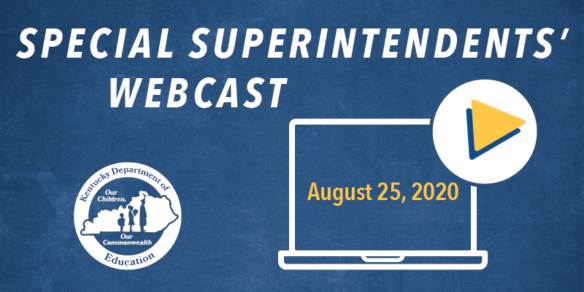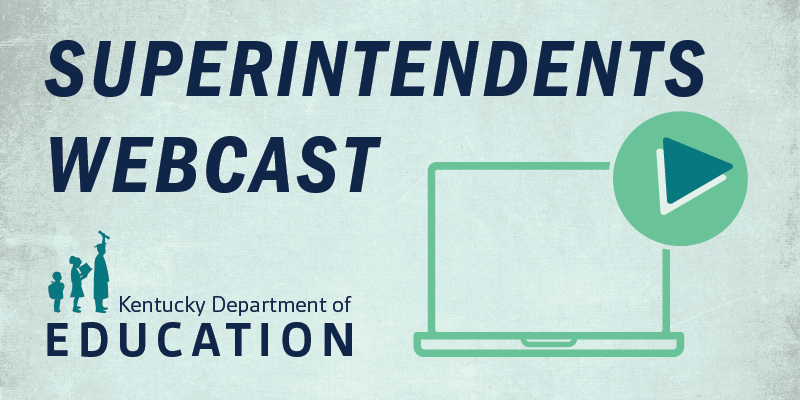
By Jim Gaines
jim.gaines@education.ky.gov
Four members of the Kentucky Department of Education’s (KDE) Commissioner’s Student Advisory Council joined the Aug. 25 Special Superintendents’ Webcast to talk about COVID-19 issues they’re hearing from their home districts.
“We’ve had just great feedback from these students,” said KDE Interim Commissioner of Education Kevin C. Brown.
Trevin Bevins, a junior at Shelby Valley High School in Pike County, said the top concern he’s hearing is getting students back in schools. Teachers were relieved by Gov. Andy Beshear’s recommendation to delay in-person classes until Sept. 28, but COVID-19 infections must be contained by then for the reopening of school buildings to work, Bevins said.
High-risk populations must be protected, including students’ families, he said.
“Many grandparents here in Eastern Kentucky raise their grandchildren,” Bevins said.
Online classes already have started for Anastasia Panaretos, a sophomore at South Oldham High School (Oldham County). When schools suddenly shut down in-person classes last spring, it created a lot of confusion about curriculum, especially among younger children, she said. Panaretos said she is glad to see the delivery of non-traditional instruction has improved for the fall.
But access to technology still is an issue in some places, although most counties have done a lot to improve it, she said.
For Caleb Bates, a senior at Breathitt County High School, the safety of students and their families is the top concern. He also would like to see schools place more emphasis on mental health issues resulting from the disruption, along with better internet connectivity.
“In Eastern Kentucky where I’m from, internet access is not all that great,” Bates said.
Anna Williams, a senior at Anderson County High School, agreed that mental health should be a priority for attention by school officials as students and athletes experience the stress of resuming school after periods of isolation.
Toni Konz Tatman, interim communications director for the Kentucky Department of Education (KDE), urged any school districts that don’t have their own student advisory councils to set them up. Although they would have to meet virtually, such councils are good for getting feedback on any topic district officials are discussing, she said.
New COVID-19 Survey
In addition to its regular process for recording COVID-19 cases, the Kentucky Department for Public Health (DPH) is working on a quick, four-question survey that will ask each district its daily counts for positive COVID-19 cases among students and staff, and the number of students and staff under quarantine, said Dr. Steven Stack, DPH commissioner. The regular process is more accurate, but slower, and the intent of the new survey is to offer immediate information to communities, he said. Details will be coming soon.
School districts should maintain their normal relationship with local health departments for questions and specific guidance, Stack said.
The DPH COVID-19 webpage includes a K-12 School Public Health Report, which breaks down daily confirmed cases by students and staff for each school district, collected and verified by local health departments, said Dr. Connie White, DPH deputy commissioner.
The four-question survey now under development is expected to show different numbers because those cases will not all be confirmed and will report on a different timeline, but it will offer communities some information faster, she said.
Health officials are working with KDE on parameters for what level of COVID-19 cases should lead to school closure, Stack said. That metric has limitations, but there is a strong public desire for some standard, he said. Stack’s hope is to have it available within a couple of weeks so schools can plan before most reopen for in-person classes Sept. 28.
Tighter COVID-19 Guidance
The flagship Healthy at School guidance, which KDE issued in June in partnership with DPH, sets good standards but is no longer sufficient on its own due to a subsequent spike in COVID-19 infections, White said. Weekly positive tests have increased fourfold since Healthy at School was released, she said. Cases have plateaued since Gov. Beshear’s July 10 mask mandate, but they aren’t yet declining, White said. It’s hoped that numbers will go down by the time most schools reopen for in-person classes on Sept. 28, she said.
Addressing claims that the spike in cases is attributable solely to increased testing, White said tests have increased – but not nearly enough to account for the number of positive results.
“The increase in positive tests is because we have more people infected,” she said.
This is especially dangerous for Kentuckians over age 80, who make up about 5% of the state’s population but account for nearly half of the COVID-19 deaths, White said. Health and education officials are worried about the effects of keeping schools closed, but believe those are currently outweighed by the danger of disease, she said.
If infection rates are still high Sept. 28, the guidance may become more restrictive, Brown said.
When the initial guidance was being drawn up, health officials wanted to require both masks and social distancing at all times in schools, per recommendations from the U.S. Centers for Disease Control and Prevention, Stack said. Schools that are opening for in-person classes before Sept. 28 should consider that, along with increased cohorting of student groups and staggered use of hallways, he said.
“That’s a hint. I would recommend you do,” Stack said.
Sports Guidance Coming
The Kentucky High School Athletic Association’s (KHSAA) Board of Control voted Aug. 20 to allow fall sports practice to begin on Aug. 24, and for games to start on Sept. 7. The organization still is working on detailed guidance for holding competitions, said KHSAA Commissioner Julian Tackett. It will seek feedback from KDE, DPH and the governor’s office, and post a final version as soon as it is available, Tackett said. Guidance on spectator attendance limits will follow.
KHSAA debated pushing back start dates, but faced public pressure to move ahead, Tackett said. He stressed that the latest decision gives schools an “opportunity” to hold sports, leaving the decision up to local districts.
Most of the coming guidance will say “local choice, but consider this,” Tackett said. He knows some districts want step-by-step rules, but each school’s facilities differ.
Much of the document will refer districts to existing KDE guidance on sanitization and transportation, Tackett said.
“Our entire intent was not to reinvent wheels,” he said.
Kay Kennedy, education consultant in the KDE Office of Finance and Operations, addressed long bus trips for on-the-road sporting events. The general idea is that all riders must wear masks at all times and remain at least 6 feet apart, she said. That means districts likely will have to use extra buses to maintain distancing, which will cost more, Kennedy said. Some districts allow parents to drive their students home from such events, she said.
MORE INFO …
- Aug. 25 Special Superintendents’ Webcast
- KDE’s COVID-19 webpage
- KDE’s COVID-19 Reopening Guidance webpage
- Kentucky COVID-19 Hotline (800) 722-5725




Leave A Comment